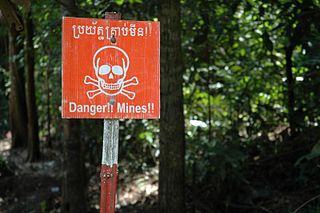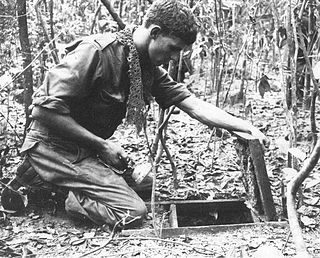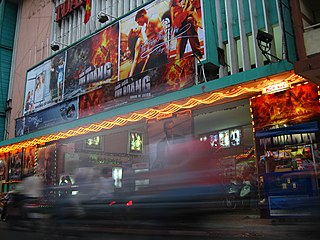Related Research Articles

A land mine is an explosive device concealed under or on the ground and designed to destroy or disable enemy targets, ranging from combatants to vehicles and tanks, as they pass over or near it. Such a device is typically detonated automatically by way of pressure when a target steps on it or drives over it, although other detonation mechanisms are also sometimes used. A land mine may cause damage by direct blast effect, by fragments that are thrown by the blast, or by both. Landmines are typically laid throughout an area, creating a minefield which is dangerous to cross.
A booby trap is a device or setup that is intended to kill, harm or surprise a human or another animal. It is triggered by the presence or actions of the victim and sometimes has some form of bait designed to lure the victim towards it. The trap may be set to act upon trespassers that enter restricted areas, and it can be triggered when the victim performs an action. It can also be triggered by vehicles driving along a road, as in the case of improvised explosive devices (IEDs).

The Sino-Vietnamese War was a border war fought between China and Vietnam in early 1979. China launched an offensive in response to Vietnam's actions against the Khmer Rouge in 1978, which ended the rule of the Chinese-backed Khmer Rouge. Both China and Vietnam claimed victory in the last of the Indochina Wars.

The tunnels of Củ Chi are an immense network of connecting tunnels located in the Củ Chi District of Ho Chi Minh City (Saigon), Vietnam, and are part of a much larger network of tunnels that underlie much of the country. The Củ Chi tunnels were the location of several military campaigns during the Vietnam War, and were the Viet Cong's base of operations for the Tết Offensive in 1968.

Estimates of casualties of the Vietnam War vary widely. Estimates include both civilian and military deaths in North and South Vietnam, Laos, and Cambodia.
The Indochina Wars was a series of wars which were waged in Southeast Asia from 1946 to 1991, by communist Indochinese forces against anti-communist forces. The term "Indochina" originally referred to French Indochina, which included the current states of Vietnam, Laos, and Cambodia. In current usage, it applies largely to a geographic region, rather than to a political area. The wars included:

The Vietnamese famine of 1945 was a famine that occurred in northern Vietnam in French Indochina during World War II from October 1944 to late 1945, which at the time was under Japanese occupation from 1940 with Vichy France as a ally of Nazi Germany in Western Europe. Between 400,000 and 2 million people are estimated to have starved to death during this time.

Bernard B. Fall was a prominent war correspondent, historian, political scientist, and expert on Indochina during the 1950s and 1960s. Born in Austria, he moved with his family to France as a child after the Anschluss. He started fighting for the French Resistance at the age of 16 and later for the French Army during World War II.

The United Nations Convention on Certain Conventional Weapons, concluded at Geneva on October 10, 1980, and entered into force in December 1983, seeks to prohibit or restrict the use of certain conventional weapons which are considered excessively injurious or whose effects are indiscriminate. The full title is Convention on Prohibitions or Restrictions on the Use of Certain Conventional Weapons Which May Be Deemed to Be Excessively Injurious or to Have Indiscriminate Effects. The convention covers land mines, booby traps, incendiary devices, blinding laser weapons and clearance of explosive remnants of war.

Cambodia is a country located in Southeast Asia that has a major problem with landmines, especially in rural areas. This is the legacy of three decades of war which has taken a severe toll on the Cambodians; it has some 40,000 amputees, which is one of the highest rates in the world. The Cambodian Mine Action Centre (CMAC) estimates that there may be as many as four to six million mines and other pieces of unexploded ordnance in Cambodia. Some estimates, however, run as high as ten million mines.

Operation Crimp, also known as the Battle of the Ho Bo Woods, was a joint US-Australian military operation during the Vietnam War, which took place 20 kilometres (12 mi) north of Cu Chi in Binh Duong Province, South Vietnam. The operation targeted a key Viet Cong headquarters that was believed to be concealed underground, and involved two brigades under the command of the US 1st Infantry Division, including the 1st Battalion, Royal Australian Regiment which was attached to the US 173rd Airborne Brigade. Heavy fighting resulted in significant casualties on both sides, but the combined American and Australian force was able to uncover an extensive tunnel network covering more than 200 kilometres, at the cost of 8 Australians and 14 Americans killed and 29 Australians and 76 Americans wounded.

The cinema of Vietnam originates in the 1920s and has largely been shaped by wars that have been fought in the country from the 1940s to the 1970s. The better known Vietnamese language-films include Cyclo, The Scent of Green Papaya and Vertical Ray of the Sun, all by French-trained Việt Kiều director Tran Anh Hung. In recent years, as Vietnam's film industry has modernized and moved beyond government-backed propaganda films, contemporary Vietnamese filmmakers have gained a wider audience with films such as Buffalo Boy, Bar Girls and The White Silk Dress.

An anti-handling device is an attachment to or an integral part of a landmine or other munition such as some fuze types found in general-purpose air-dropped bombs, cluster bombs and sea mines. It is designed to prevent tampering or disabling, or to target bomb disposal personnel. When the protected device is disturbed, it detonates, killing or injuring anyone within the blast area. There is a strong functional overlap of booby traps and anti-handling devices.

Operation Camargue was one of the largest operations by the French Far East Expeditionary Corps and Vietnamese National Army in the First Indochina War. It took place from 28 July until 10 August 1953. French armored platoons, airborne units and troops delivered by landing craft to the coast of central Annam, modern-day Vietnam, attempted to sweep forces of the communist Viet Minh from the critical Route One.

VC and PAVN battle tactics comprised a flexible mix of guerrilla and conventional warfare battle tactics used by Viet Cong (VC) and the North Vietnamese People's Army of Vietnam (PAVN) to defeat their U.S. and South Vietnamese (GVN/ARVN) opponents during the Vietnam War.
A cartridge trap is a type of booby trap devised by the Viet Cong and subsequently used against American and other anti-Communist forces supporting South Vietnam during the Vietnam War. It derives its name from the fact that the wounding component of the trap is a small arms cartridge.

The Khmer People's National Liberation Armed Forces (KPNLAF) was the military component of the Khmer People's National Liberation Front (KPNLF) a political front organized in 1979 in opposition to the Vietnamese-installed People's Republic of Kampuchea (PRK) regime in Cambodia. The KPNLAF was loyal to Son Sann, a former Prime Minister under Prince Norodom Sihanouk and the founder of the KPNLF political movement.

Plain of Reeds is an inland wetland in Vietnam's Mekong Delta. Most of the wetlands are within Long An Province and Đồng Tháp Province.
Operation Cochise Green was a security and pacification operation during the Vietnam War conducted by the 173rd Airborne Brigade in Bình Định Province from 30 March 1968 to 31 January 1969.

The Battle of Cao Ba Lanh was part of the Battle of Móng Cái, fought during the Sino-Vietnamese War between February and March 1979 near the city of Móng Cái and other districts of Quảng Ninh Province that bordered the People's Republic of China. The battle broke out as Chinese People's Liberation Army (PLA) units launched diversionary attacks in support of the Chinese invasion in the major fronts of Lạng Sơn, Cao Bằng and Lào Cai. A Chinese regiment clashed with a Vietnamese platoon, taking heavy casualties to seize the strategic peak which was later recaptured by reinforcements.
References
- ↑ Landmine Monitor Report - Page 514 1999 - "Use - Mines were used in all phases of the war in Vietnam, including by the French forces in the 1950s.7" [footnote] "7. International Committee of the Red Cross. Landmines, Friend or Foe? Geneva, March 1996"
- ↑ John L. Plaster SOG: the secret wars of America's commandos in Vietnam 1997 "Mining a back trail was easy using the M-14 "toe popper," a mine that was the diameter of a soda can but only one-third as long ... Designed to injure one foot — hence its nickname — the toe popper was compact and carried by the dozen."
- ↑ The Rotarian - Feb 2011 - Page 34 Vol. 189, No. 8 "The M14 blast-type anti-personnel mine used by the United States during the Vietnam War was known as the "toe-popper." Earlier examples of the toe-popper were the Soviet-made PMK-40 and the British-made "ointment box."
- ↑ Marvin G. Jensen Strike swiftly!: the 70th Tank Battalion from North Africa to Normandy to Germany 1997 "(Shermans with drums protruding in front with heavy chains that "flailed" the ground, exploding mines close to the surface.) Also there were "ointment box" mines, so called because that was what they resembled."
- ↑ Lawson, Don (1981). The United States in the Vietnam war . Crowell. p. 58. ISBN 978-0-690-04104-0. "Dap loi were made from empty .50 caliber machine gun shells that were filled with new powder and chunks of scrap ... They included carefully concealed land mines, grenades triggered by hidden trip wires placed alongside jungle trails or on.."
- ↑ vnmilitaryhistory.net "Thí dụ, chế tạo đạp lôi từ đạn súng trường, súng máy; cải tiến pháo thu được của địch để làm mìn, v.v… Đạp lôi - vũ khí lợi hại của chiến tranh nhân dân." đạp lôi (photo)
- ↑ "Mìn muỗi ngòi nụ xùy. 24. Mìn lá kiểu Bến Tre"
- ↑ What Can You Do to Help Our World?: Dreams Turned Into Reality - Page 35 Barbara Wolf, Margaret Anderson - 2012 "At first, the foundation's concentration was on Vietnam because land mines in the Vietnam War resulted in 20% amputee casualties within the Vietnam population. Returning American veterans appealed to Dr. Burgess to help the victims."
- ↑ Landmines: A Deadly Legacy - Page 18 Physicians for Human Rights (U.S.) - 1993 - 510 pages - Full view Vietnamese forces, which used several dozen types of improvised or simply manufactured mines, proved that advanced technology was not needed to deploy landmines with deadly effectiveness. In 1965, one year for which detailed statistics are available, 65–70% of US Marine Corps casualties were caused by mines and booby-traps....
- ↑ Congressional Record - Page 20595 Congress -""Fact is, anti-personnel land mines were the leading cause of our casualties in Vietnam," Muller said, "and they are the leading cause of casualties for our peacekeepers through NATO and the UN," not to mention the peril they now pose "
- ↑ Landmine Monitor Report - Page 726 2003 Total US humanitarian mine action funding to Vietnam was $3.638 million in US fiscal year 2002. ... in April 2002 for assistance in clearing mines and UXO along the route of the Ho Chi Minh Highway.90 International NGOs working in mine ..."